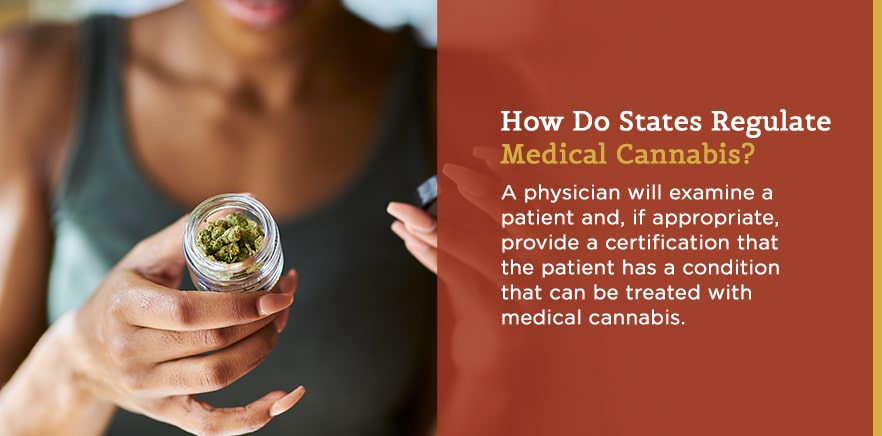Cannabis Laws by State
Since California’s pioneering legislation in 1996, cannabis laws in the United States have undergone significant changes. With many states legalizing cannabis for medical or adult use, staying informed can be challenging. This page provides a cannabis map to help you understand the current landscape of cannabis laws by state.
- Adult Use
- Medical
- Decriminalized
- High CBD, Low THC
- Illegal
| State | Adult Use | Medical | Decriminalized | State Law |
|---|
Our clients come first.
Learn More about Harris SliwoskiIn Which States Is Cannabis Legal?
As a look at the map makes clear, states continue to take a variety of approaches to regulating cannabis. While a few states still have outright bans, the trend has been toward loosening restrictions. Most states now allow the use of cannabis for medical purposes. An increasing number have also legalized recreational use or greatly reduced the penalties for possessing or using cannabis.
How Do States Decide on Their Cannabis Laws?
For decades, states have been changing their cannabis laws through both ballot initiatives and the legislative process. In states including California, South Dakota and New Jersey, voters have directly approved measures legalizing medical cannabis, recreational cannabis or both.
State legislatures have been passing laws to allow medical cannabis since the 1990s. In 2018, Vermont became the first state to legalize recreational cannabis through its legislature rather than through a ballot initiative. Since then, legislatures in states including Illinois and Virginia have followed suit.
A state’s cannabis laws don’t address every detail of how its system works. Instead, the law creates a framework within which state agencies and local governments can make more specific rules.
What Is Medical Cannabis?
Medical cannabis, as the name suggests, is prescribed by a doctor to treat specific conditions and symptoms. Studies have shown that cannabis can help patients with a variety of health concerns, including:
- Certain kinds of epilepsy.
- Nausea and vomiting caused by chemotherapy treatments for cancer.
- The loss of appetite and weight loss that can be caused by HIV/AIDS.
Scientists continue to study whether cannabis is an effective treatment for some symptoms of multiple sclerosis, chronic pain and other conditions.
How Do States Regulate Medical Cannabis?
Each state’s medical cannabis program is unique, but they share important similarities.
A physician will examine a patient and, if appropriate, provide a certification that the patient has a condition that can be treated with medical cannabis. Each state has its own list of qualifying conditions.
Once a patient has a physician’s certification, they can be placed on the state’s medical cannabis registry and issued an identification card. This card entitles them to purchase cannabis at a dispensary — a state-regulated store that is authorized to sell cannabis products. The amount of cannabis someone with a medical cannabis card can possess varies by state.
Another important difference between states is whether they recognize other states’ medical cannabis cards. Individuals must follow the rules of the state they are in, not just the state that issued their ID.
What Is Cannabis Decriminalization?
In addition to implementing and refining medical cannabis programs, states are also continuing to address the question of how to regulate the nonmedical use and possession of cannabis. As the map shows, many states now allow adults to possess and use cannabis with some restrictions. Others have opted instead for decriminalization.
Decriminalization of cannabis does not mean legalization of cannabis. Instead, decriminalization can reduce the legal consequences of those caught possessing or using cannabis.
Decriminalization generally means criminal penalties are replaced with civil penalties. For example, police would issue a citation instead of making an arrest, would not punish an individual with a jail or prison sentence, and the incident would not appear on the individual’s criminal record.
It’s important to note that these more lenient punishments generally only apply to the first-time possession of smaller amounts of cannabis — harsher penalties can be imposed for multiple infractions or for possessing larger amounts.
What Is CBD?
The Cannabis sativa plant contains both delta-9 tetrahydrocannabinol (THC) — the chemical compound found in medical and recreational cannabis — and cannabidiol (CBD). THC is psychoactive — it’s the chemical in cannabis that causes a “high.” CBD is not psychoactive. For this reason, many states have begun loosening restrictions on its use for medicinal and other purposes.
At both the state and federal levels, however, the law surrounding CBD remains complicated and unsettled. This is especially true when it comes to the presence of THC in CBD products. Since the two compounds are chemically similar and derived from the same plant, many CBD products contain some THC. Some states that allow CBD products but have more restrictive laws for THC have specified that CBD products may not contain more than a certain small amount of THC.
By isolating and extracting the CBD from Cannabis sativa plants, it is possible to create CBD-only products. Since these products contain no THC at all, they reduce some of the risk and uncertainty surrounding the production, sale and use of CBD.
Navigating State Cannabis Laws
The laws addressing recreational cannabis, medical cannabis and CBD continue to evolve. We’ll continue to update our map to reflect changes to each state’s cannabis laws. If you have questions about how specific laws affect your cannabis business, you can always reach out to us — we’ll help you find the answers.













